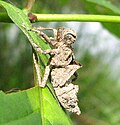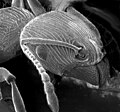Coccolithophore shells Many protists have protective shells or tests, usually made from silica (glass) or calcium carbonate (chalk). Protists are a diverse...
41 KB (3,843 words) - 18:33, 13 September 2024
A protist (/ˈproʊtɪst/ PROH-tist) or protoctist is any eukaryotic organism that is not an animal, land plant, or fungus. Protists do not form a natural...
95 KB (9,835 words) - 08:24, 4 October 2024
Marine protists Marine protists are defined by their habitat as protists that live in marine environments, that is, in the saltwater of seas or oceans...
133 KB (10,590 words) - 01:51, 21 October 2024
Nacre (redirect from Pearl shell)
organic–inorganic composite material produced by some molluscs as an inner shell layer. It is also the material of which pearls are composed. It is strong...
36 KB (3,894 words) - 06:46, 11 August 2024
Test (biology) (redirect from Test (shell))
In biology, a test is the hard shell of some spherical marine animals and protists, notably sea urchins and microorganisms such as testate foraminiferans...
6 KB (656 words) - 09:06, 14 October 2024
hardened secretion of stony corals and the prominent mollusc shell shared by snails, clams, tusk shells, chitons and nautilus. Some vertebrate animals, such as...
19 KB (2,136 words) - 16:12, 13 July 2024
Diatomaceous earth consists of the fossilized remains of diatoms, a type of hard-shelled microalgae, that have accumulated over millions of years. It is used as...
41 KB (4,382 words) - 05:27, 24 October 2024
in biological systems, such as the formation of stromatolites or mollusc shells (see Biomineralization). Calcification can manifest itself in many ways...
9 KB (925 words) - 23:26, 16 September 2024
The mollusc (or mollusk) shell is typically a calcareous exoskeleton which encloses, supports and protects the soft parts of an animal in the phylum Mollusca...
41 KB (4,866 words) - 01:10, 3 November 2024
as cuttlefish bone, is a hard, brittle internal structure (an internal shell) found in all members of the family Sepiidae, commonly known as cuttlefish...
16 KB (1,651 words) - 05:23, 31 October 2024
and cuttlefish) have an internalized vestigial aragonite/calcite-chitin shell known as gladius or cuttlebone, which can serve as muscle attachments but...
5 KB (590 words) - 10:58, 8 July 2024
(shells) Arthropod exoskeleton cuticle Brachiopod shell Cephalopod shell cirrate shell cuttlebone gladius Lorica Choanoflagellate lorica Protist shell...
10 KB (1,157 words) - 07:56, 20 October 2024
another example, many fossil genera of Foraminifera, which are protists are known from shells (called tests) that were as big as coins, such as the genus...
61 KB (6,338 words) - 22:11, 12 September 2024
predator to utilise the organic content of coccolithophores. Heterotrophic protists are able to selectively choose prey on the basis of its size or shape and...
25 KB (2,538 words) - 20:02, 17 September 2024
(shells) Arthropod exoskeleton cuticle Brachiopod shell Cephalopod shell cirrate shell cuttlebone gladius Lorica Choanoflagellate lorica Protist shell...
19 KB (2,141 words) - 06:23, 29 June 2024
class of Rhizarian protists characterized by streaming granular ectoplasm for catching food and other uses; and commonly an external shell (called a "test")...
87 KB (8,497 words) - 14:56, 27 October 2024
as support, defense, and feeding. Many protists, like this coccolithophore, have protective mineralised shells. Forams from a beach Many invertebrate...
100 KB (10,349 words) - 16:56, 3 November 2024
Foraminifera test (redirect from Foram shell)
(or shells) of Foraminifera. Foraminifera (forams for short) are single-celled predatory protists, mostly marine, and usually protected with shells. These...
30 KB (3,215 words) - 08:52, 26 October 2024
The gastropod shell is part of the body of a gastropod or snail, a kind of mollusc. The shell is an exoskeleton, which protects from predators, mechanical...
33 KB (3,930 words) - 21:03, 26 October 2024
Coccolithophore (section Coccolithophore shells)
predator to utilise the organic content of coccolithophores. Heterotrophic protists are able to selectively choose prey on the basis of its size or shape and...
90 KB (9,375 words) - 10:01, 30 August 2024
silicate shells. Phytoplankton that build calcium-carbonate shells (i.e. coccolithophores) release carbon dioxide as a byproduct during shell formation...
25 KB (3,108 words) - 12:53, 6 June 2024
Small shelly fauna (section Minerals used in shells)
shells. These animals may have been molluscs or worm-like Sipuncula. Other molluscan univalved shells have been found in Canada. Some bivalve shells have...
40 KB (4,942 words) - 22:10, 29 August 2024
(shells) Arthropod exoskeleton cuticle Brachiopod shell Cephalopod shell cirrate shell cuttlebone gladius Lorica Choanoflagellate lorica Protist shell...
8 KB (943 words) - 19:49, 4 October 2023
Amoeba (redirect from Amebas (pseudopodia protists))
are no longer classified together in one group. The best known amoeboid protists are Chaos carolinense and Amoeba proteus, both of which have been widely...
51 KB (4,920 words) - 08:03, 3 November 2024
development of the larval shell, but not the adult conch (a separate entity), suggesting a different evolutionary origin of the mature shell. In cephalopods, engrailed...
10 KB (1,050 words) - 04:01, 25 July 2024
fluids seep into the voids of Earth materials, e.g., rocks, wood, bones, shells, and replace the original materials with silica (SiO2). Silica is a naturally...
31 KB (3,436 words) - 12:04, 27 September 2023
(shells) Arthropod exoskeleton cuticle Brachiopod shell Cephalopod shell cirrate shell cuttlebone gladius Lorica Choanoflagellate lorica Protist shell...
6 KB (708 words) - 05:25, 12 May 2023
(shells) Arthropod exoskeleton cuticle Brachiopod shell Cephalopod shell cirrate shell cuttlebone gladius Lorica Choanoflagellate lorica Protist shell...
5 KB (487 words) - 02:50, 9 November 2021
functional biominerals, such as endoskeletons and exoskeletons, protective shells, or teeth, had been a significant step in animal evolution. Calcium carbonate...
71 KB (7,846 words) - 15:12, 2 November 2024


























